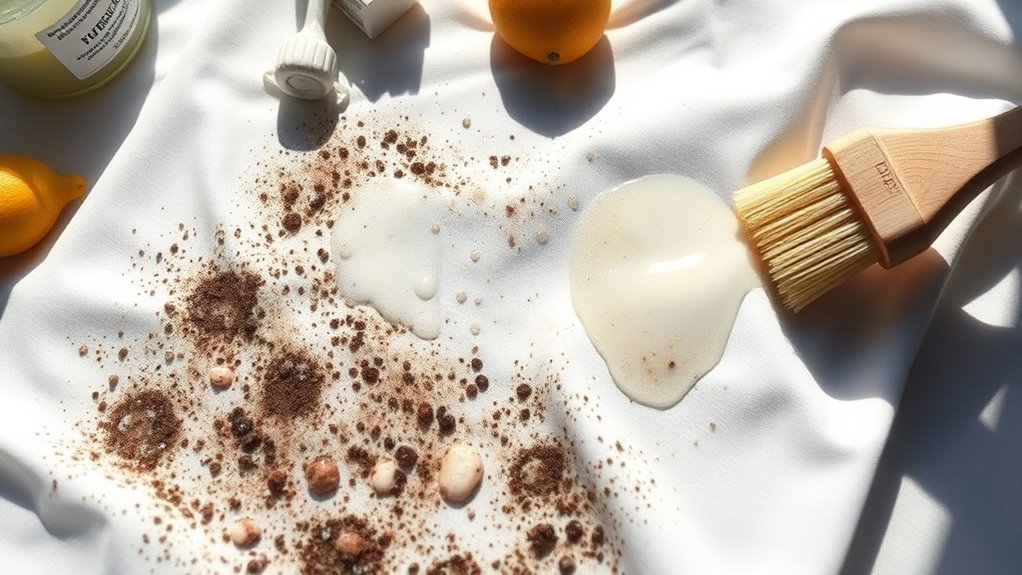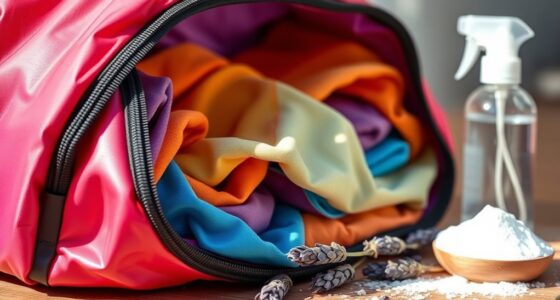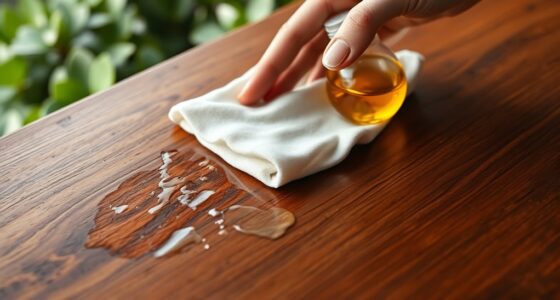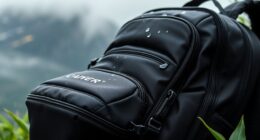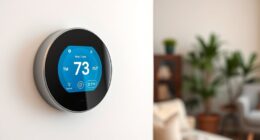To eliminate mold and mildew stains from fabrics, start by brushing off visible spores outdoors. For washable items, apply heavy-duty detergent and soak in equal parts water and vinegar. Wash in the hottest water safe for the fabric and add disinfectants. For upholstery, use a vinegar-water solution or a commercial cleaner. Maintain good ventilation and low humidity to prevent future growth. Keep going to uncover specialized cleaning solutions for different materials.
Key Takeaways
- Brush off visible mold spores outdoors to minimize spreading before cleaning.
- Pre-soak fabric in equal parts water and vinegar for 30-60 minutes to loosen stains.
- Apply heavy-duty laundry detergent directly to stains and let it sit for 15 minutes.
- Wash fabrics in the hottest water safe for them, adding disinfectants like chlorine bleach.
- Hang items outside to dry in sunlight, which helps disinfect and prevent mold regrowth.
Prevention of Mold and Mildew Growth
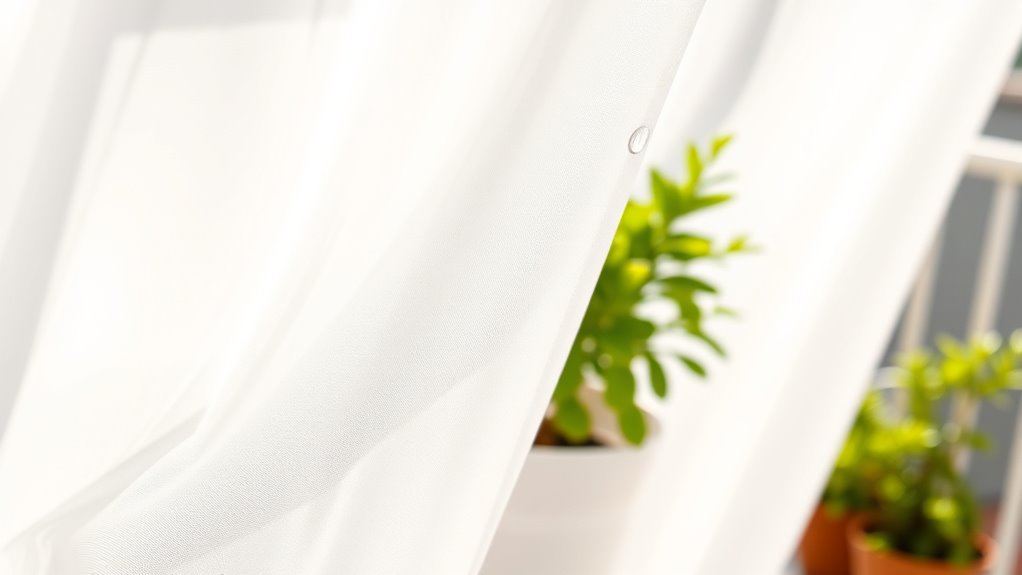
To prevent mold and mildew growth on fabrics, it’s crucial to choose the right materials and implement effective storage strategies.
Opt for high-quality fabrics like polyolefin and polyester, which resist mildew naturally. Treat fabrics with special coatings for added protection. For outdoor use, select inherently mildew-resistant yarn types.
Guarantee proper ventilation by positioning furniture in airy spaces and avoiding confined areas that trap moisture. Utilize dehumidifiers to control humidity levels, and always store fabrics in cool, dry, well-ventilated areas. Mildew thrives in warm, damp environments, making it essential to monitor the surrounding conditions of your storage spaces.
Regularly inspect your storage areas for moisture signs, and keep an eye on temperature fluctuations. By making these choices, you can greatly reduce the risk of mold and mildew affecting your fabrics.
Identifying Mold and Mildew Damage
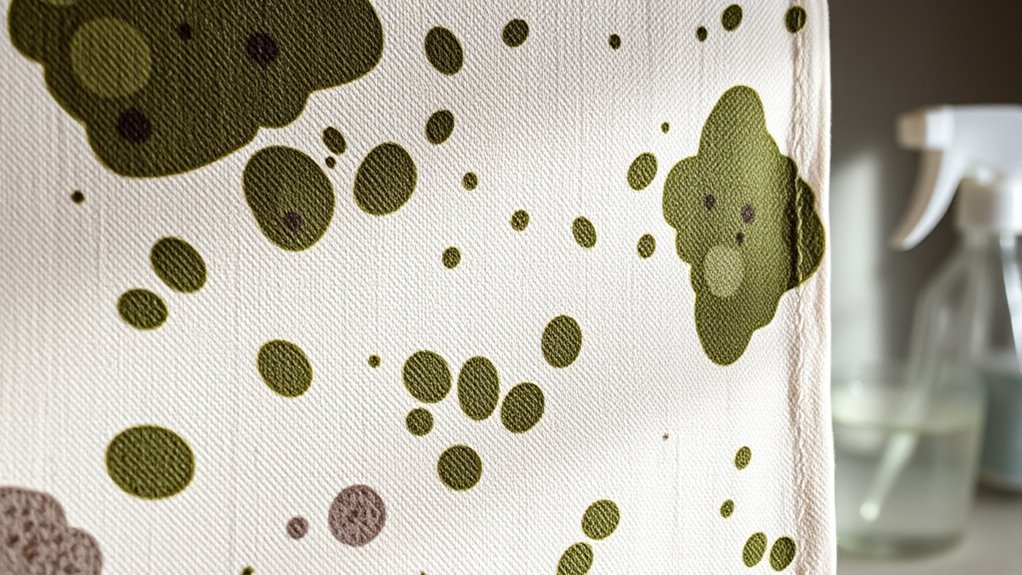
Even with the best prevention strategies in place, mold and mildew can still find their way onto your fabrics.
To identify damage, look for irregular spots in various colors like black, green, or red for mold, which often has a fuzzy texture. Mildew appears as flat, powdery patches in gray or white. Discoloration, such as green or brown stains, signals potential growth. Additionally, natural fibers are particularly susceptible to mold and mildew, making them more likely to show signs of damage.
Pay attention to odors; a musty smell indicates mold, while a sour scent suggests mildew. Both thrive in high humidity and poor ventilation, especially on natural fibers.
Removing Mold Stains From Washable Fabrics
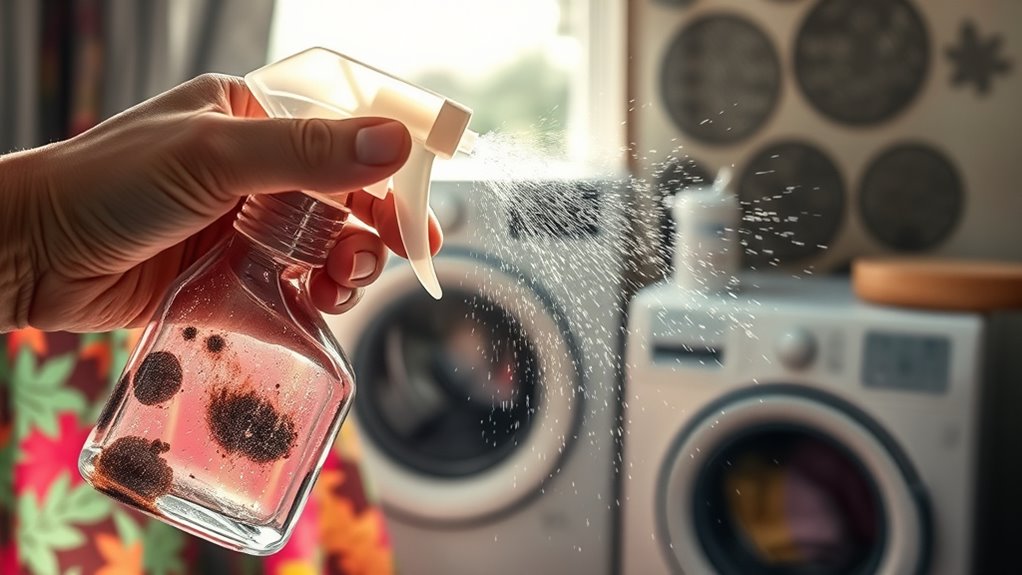
Mold stains on washable fabrics can be a persistent problem, but tackling them effectively is key to restoring your items.
Start by brushing off visible mold spores outside to prevent spreading. Next, apply heavy-duty liquid laundry detergent directly to the stains and let it sit for at least 15 minutes.
Begin by brushing off mold spores outdoors, then apply heavy-duty detergent to the stains and let it sit for 15 minutes.
For a deeper clean, pre-soak the fabric in a solution of equal parts water and vinegar for 30 to 60 minutes. Wash in the hottest water suitable for the fabric, adding a disinfectant like chlorine bleach or borax. Wearing protective gear such as gloves and a dust mask during the cleaning process is essential for your safety.
Finally, hang clothes outside to dry in the sunlight, as this helps disinfect and prevents mold regrowth. If stains persist, repeat the process until they’re fully eliminated.
Specialized Cleaning Solutions for Different Fabrics
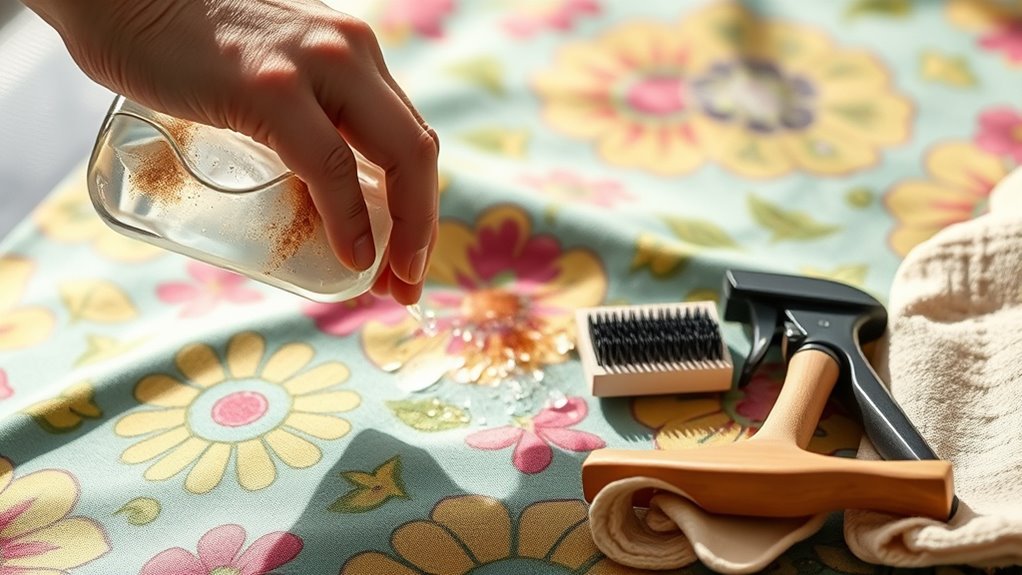
When tackling mold and mildew stains, it’s essential to use specialized cleaning solutions tailored to the type of fabric you’re dealing with.
For cotton, mix equal parts vinegar and water, spray on the stain, and let it sit for 15-20 minutes before rinsing. You can also add ½ cup of baking soda during the wash. Mold thrives in damp and humid conditions, so ensuring that cotton items are fully dried after cleaning is crucial.
For synthetic fabrics, opt for enzyme-based stain removers or a diluted ammonia solution.
Delicate fabrics require spot cleaning with vinegar and a soft brush, avoiding harsh chemicals.
Always test any solution in an inconspicuous area first.
Treatment for Upholstery and Non-Washable Fabrics
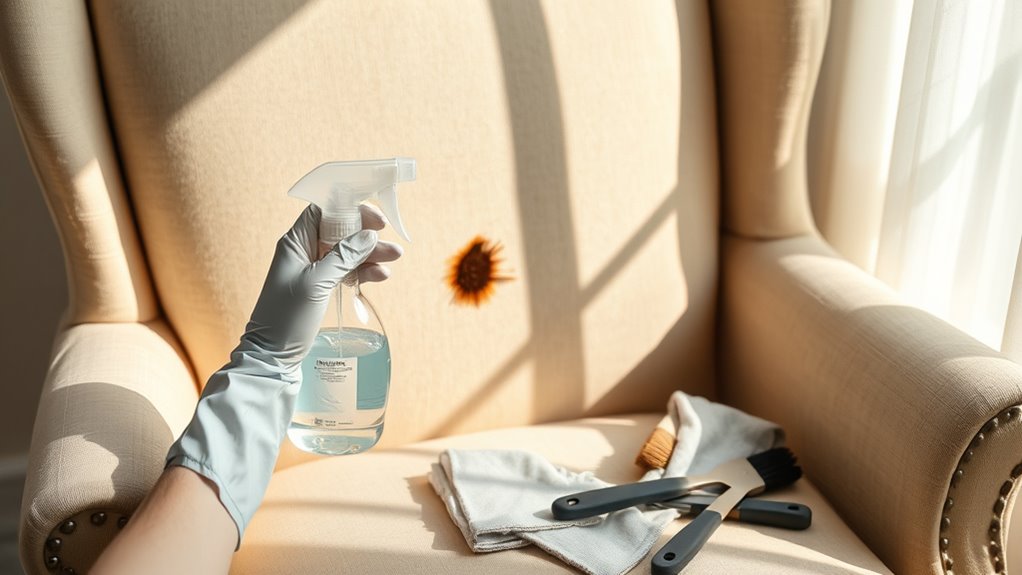
To effectively treat upholstery and non-washable fabrics for mold and mildew, start by evaluating the extent of the infestation. Isolate the affected areas to prevent spores from spreading to other furniture. Gently brush away any dust or debris before applying a cleaning solution. A mixture of equal parts water and white vinegar works well, or you can opt for commercial cleaners like Mold Armor Rapid Clean. For non-washable fabrics, try an isopropyl alcohol solution or a baking soda paste for stubborn spots. Inhaling mold spores may cause allergic reactions in sensitive individuals, so it’s important to take precautions while cleaning. Sunlight exposure can help eliminate spores, so dry your fabrics outdoors if possible. Guarantee good air circulation and avoid high humidity to prevent mold from returning. Regular monitoring is crucial for long-term success.
Frequently Asked Questions
Can Mold Stains Become Permanent if Not Treated Promptly?
Yes, mold stains can become permanent if you don’t treat them promptly.
The longer you wait, the more deeply the stains penetrate the fabric fibers, making removal increasingly difficult. If untreated for over a week, you greatly increase the chances of irreversible changes in color and texture.
Additionally, mold spores can spread to other areas, complicating the situation further.
How Can I Prevent Mold From Returning After Cleaning?
To prevent mold from returning after cleaning, you’ve got to keep moisture levels low and improve air circulation.
Use dehumidifiers in damp areas and guarantee proper ventilation by opening windows.
Regularly clean and vacuum your spaces to eliminate mold spores.
Make certain your fabrics are completely dry before storage and use breathable containers.
Monitor humidity levels, and consider using natural antifungals like essential oils to deter any mold growth.
Is Mold Exposure Harmful to Health?
Ever wondered how something so small could impact your health? Mold exposure can be harmful, causing symptoms like sneezing, itchy eyes, and even respiratory issues.
If you’ve got asthma, mold can trigger attacks. You might also feel headaches or fatigue due to volatile compounds from mold.
High-risk groups, like those with weakened immune systems, face even greater dangers. It’s crucial to recognize these risks and take steps to protect yourself and your loved ones.
What Are the Best Storage Practices for Preventing Mold?
To prevent mold, you need to focus on proper storage practices.
Use climate-controlled units to maintain ideal temperature and humidity. Guarantee adequate ventilation by spacing containers, and consider installing dehumidifiers.
Thoroughly clean and dry items before storing, avoiding damp items entirely.
Utilize airtight plastic bins and add silica gel packs to absorb moisture.
Regularly inspect your storage area for any signs of mold and replace moisture absorbers as needed to keep everything safe.
Can I Use Essential Oils to Combat Mold Odors?
Yes, you can use essential oils to combat mold odors.
Many oils, like tea tree and lemon, have antifungal properties that help neutralize unpleasant smells.
You can diffuse these oils in your space or mix them with water in a spray bottle to freshen up areas prone to mold.
Just remember to guarantee proper ventilation while using them, and always test a small area first to avoid any adverse reactions.
Conclusion
By taking proactive steps to prevent mold and mildew, staying vigilant in identifying damage, and using the right cleaning methods, you can keep your fabrics fresh and clean. Remember, tackling stains promptly, using specialized solutions for delicate materials, and treating upholstery carefully can make a world of difference. Don’t let mold and mildew take control—act swiftly, act smart, and enjoy your clean, beautiful fabrics for years to come!
